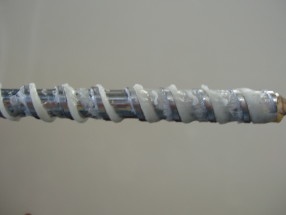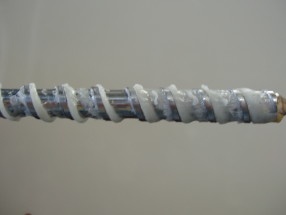
Many times when I go into a plant or am on the phone to the customer, “sealing” can feel like a magic word. When talking about contamination on the screw or scrap rates at start-up, the first question I ask the customer is “Are you sealing your machines when you shut-down?”
More often than not, not only is the answer “no” but it is actually a foreign concept. Many processors do not want to leave anything in their machines due to concerns of hang-ups, burning OR they simply don’t realize that they can!
Sealing your machine from the hopper right through to the die prevents any oxygen from entering the barrel while it is empty. N0 oxygen in the barrel means there is no chance of degradation of any residue that may be on the screw. Eliminating the opportunity for degradation to occur, in turns eliminates black specks from appearing in your production at start-up. If you seal with a virgin resin (rather than purge compound), it's likely you will have a layer/some residue of the resin left behind on the screw. You may not notice any effects of this immediately, but over time that residue will build up producing layers on your screw.
I have a customer who occasionally saw black specks appear in their product. They had no idea when the black specks would occur, and therefore had no control over them. Initially, the black specks were not an issue as they would only appear every now and then. Also, most of the time, the nature of the product meant it was not being rejected so the problem was never addressed. However, when a demanding customer came along with a need for a “perfect” end product, then the rejection rates became a huge issue.
Rejection leads to scrap.
Scrap leads to wasted production time.
All lead to loss of profits.
It is important to understand that black speck means contamination on your screw- and this should always be addressed immediately whether your product is being rejected OR NOT.
I advised my customer to purge their machine before shutdown (as per their usual plan) and LEAVE the purge inside the machine. It was a simple step that the processor just never knew he could do. And as they were already purging at the end of the day before shutdown- it was a no-brainer.
Once you have completed a purge, do not run the machine empty. Instead, leave the barrel full from the hopper to the die and turn off your heats. The processer added this simple step to his purging regime, and was able to reduce scrap rates by over 75%.
The processor couldn’t believe the difference one simple step made to his rejection rates. If you are investing in a purge compound, make sure you review your purge program and are getting the most out of the compound. Using a purging compound correctly can make a huge difference to what you get out of it.
Learn more about improving your profitability with proper purging compounds and processes.

Kiran Raza is an Asaclean Purging Expert & Technical Sales Representative. She's worked in the plastics industry for nearly 20 years and has expertise In Bio-Medical Materials, Polymer Processing, and Materials Testing.







Comments